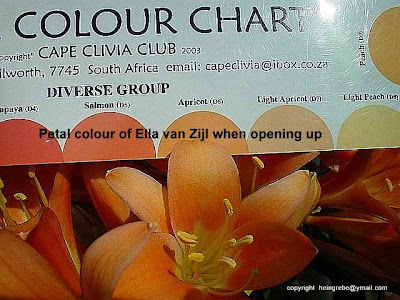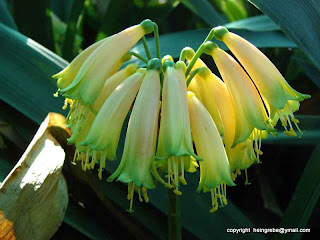I met Toy Jennings in 1998. Her love for clivia opened my eyes and after my first visit to her house I really become excited about growing clivias. She had a big collection of clivia with colours ranging from dark red, yellow, apricot, guava, orange etc. Many prize winners come from her collection and her clivia has won many prizes over the years. I can still remember the very first clivia I bought from het was a broad leaf cyrtantiflora with purplish flowers.
As a matter of fact, after a few visits, I was infected by a terrible disease called the clivia disease which forced me to have a relook at my clivia collection. Toy inherited a beautiful collection of clivia built up by her mother, Edna Jennings, over many years in 1980. When her mother died she had to look after her mother's friend Ella van Zijl, maiden surname Green, who was living in Pretoria. When she died in 1986 Toy noticed two clivias growing next to the pavement in front of her house and asked the gardener to remove them to add them to her collection. Big was the surprise when they flowered that year at her house.
Although the flowers open orange, the colour transforms into a pinkish silver. Apart from the beautiful flower colour, the flower petals curl back and the flower head forms a round ball, called by some clivia growers in the Cape a posie. This plant was in flower at the very first Clivia show being held in Pretoria in the early nineties and won the Best on Show prize. Over the years it has won more first prices at clivia shows in other parts of South Africa. Toy also discovered an almost similar plant which belonged to professor Jurie Geldenhuys of Pretoria which she named after him. Toy has listed both these plants to be auctioned at this year's international clivia conference in Cape Town.
As a matter of fact, after a few visits, I was infected by a terrible disease called the clivia disease which forced me to have a relook at my clivia collection. Toy inherited a beautiful collection of clivia built up by her mother, Edna Jennings, over many years in 1980. When her mother died she had to look after her mother's friend Ella van Zijl, maiden surname Green, who was living in Pretoria. When she died in 1986 Toy noticed two clivias growing next to the pavement in front of her house and asked the gardener to remove them to add them to her collection. Big was the surprise when they flowered that year at her house.
Although the flowers open orange, the colour transforms into a pinkish silver. Apart from the beautiful flower colour, the flower petals curl back and the flower head forms a round ball, called by some clivia growers in the Cape a posie. This plant was in flower at the very first Clivia show being held in Pretoria in the early nineties and won the Best on Show prize. Over the years it has won more first prices at clivia shows in other parts of South Africa. Toy also discovered an almost similar plant which belonged to professor Jurie Geldenhuys of Pretoria which she named after him. Toy has listed both these plants to be auctioned at this year's international clivia conference in Cape Town.












































































